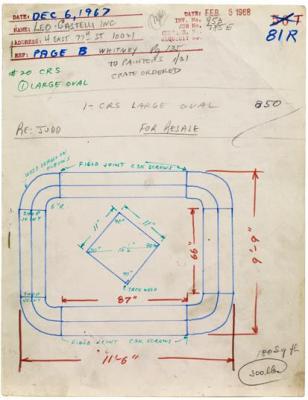Working Papers: Donald Judd Drawings, 1963-93 @ Spruth Magers – REVIEW
A giant of American Minimalism, and an early advocate of the idea that it is the end, and not the means of art, that is its merit – we have here a fascinating insight into Donald Judd’s mind at work. Curated by Peter Ballantine, who has specialized in Judd’s work since the 1960s, this is a chance to see Judd’s hand in the pieces for which he has become most famous, namely drawings for his various ‘stacks’, ‘boxes’ and ‘progressions’.
For lovers of Judd’s sculptures (if that is not too strong a word) this exhibition may seem almost sacrilegious – the signatures, the hand-drawn mark, the ponderous ‘PROBABLY LONGER’ scribbled underneath a structure reminiscent of a pared down desk. Where is the distance, the absence of symbolic expression? Famously Judd’s works are unsigned, with one piece in the Tate Collection, for instance, characteristically stamped ‘JUDD/JO/Bernstein Bros Inc./80–49’: The initials ‘JO’ are those of José Otero, a technician at Bernstein’s who made many of Judd’s metal sculptures.
It is this part of the process which is now offered up for scrutiny. And, serving as the central point around which such drawings are grouped, acting as both supporting cast and competitors for attention, are the shop drawings for the Bernstein Bros Inc firm of welders and metalworkers. These include hand-drawn specifications, dimensions, even prices. Most interesting perhaps are the raised eyebrows of quotation marks around the words “JUDD SCULPTURES”, which seem politely wary, if not openly skeptical – keeping whatever it is they are fabricating firmly at arm’s length.
In this exhibition we get a behind-the-scenes glimpse at the thought process of the artist who took a famously hands-off approach to his art, claiming ‘…The point is not whether one makes the work or not.’ The nature of artistic production, who’s actually making it, has been a controversial question in the art world for centuries – the Renaissance greats had their workshops, today Damien Hirst employs assistants because, in his own words, “I couldn’t be fucking arsed doing it”.
While the products of Judd’s thoughts are world famous and have sold for millions, this is the first opportunity to examine origins of the thoughts themselves, personal even in their attempt to suppress personality. In the contentious grey area between artist and designer, sculptor and craftsman, art and object, this exhibition summons new evidence, and carefully invites the viewer to walk the line. Words: Isabel Seligman © 2011 ArtLyst

